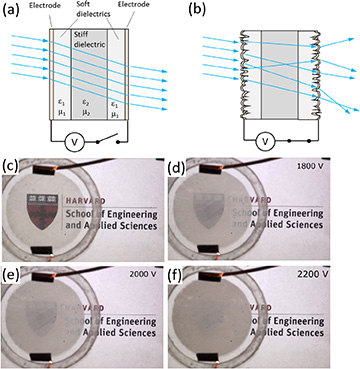
(Top) Light refracts normally through smooth elastomer-glass-elastomer sandwich (left), but diffracts when nanowire-coated elastomer is deformed by applied electric field (right). (Bottom) The opacity created by the deformed elastomer can be tuned by applying different voltage levels. [Image: S. Shian and D.R. Clarke, Opt. Lett., doi: 10.1364/OL.41.001289]
Engineering researchers at Harvard University, USA, have devised an electromechanical approach to creating windows whose opacity can be tuned with the proverbial flick of a switch (Opt. Lett., doi: 10.1364/OL.41.001289). The approach—which involves the electrostatic deformation of nanowire-coated elastomer layers—is color neutral, and could prove much cheaper to manufacture than previous, largely electrochemical techniques.
Spray-on nanowires
Numerous research groups have devised tunable-window schemes, some of them based on liquid-crystal films and others involving so-called electrochromic techniques. In the latter approach, common in commercial controllable windows, layers of electrodes and thin films of materials such as tungsten oxide are attached to clear glass or plastic using vacuum deposition techniques. When a voltage is applied to the window, an electrochemical reaction changes the oxidation state and increases the opacity of the active layer. The system works—but manufacturing these windows is expensive, and the active layer can impart a color change as well as a change in the optical transmittance.
The Harvard team, consisting of David R. Clarke and Samuel Shian, opted for a different approach, to take the expensive vacuum-deposition step out of the equation. In the tunable-window prototype they’ve developed, an ordinary sheet of glass or plastic is covered on both sides by a soft elastomer film that has been sprayed with a network of randomly oriented silver nanowires, each on the order of 90 nm in average diameter and 20 to 60 microns in length.
Opacity via physical deformation
The nanowires are too small to scatter light on their own, and so the window remains clear. However, when a voltage applied across the dielectric elastomer layer, Coulomb forces cause the nanowires to move, which in turn squeezes and deforms the elastomer in random patterns to create an uneven, wavy surface. The waves are small—but enough to scatter light.
The result is a surface that can change from transparent to opaque in less than a second, according to the researchers. The amount of opacity can be varied by varying the amount of voltage applied. And the windows are a neutral gray, versus the bluish tinge found in electrochemically driven tunable windows.
Perhaps most intriguing, the physical scheme can be implemented with a roll-on/spray-on manufacturing process potentially much cheaper and more scalable than the vacuum deposition technology required for electrochemical windows. The Harvard team is now working on ironing out some of the details required for commercialization of the technology—which, Shian and Clarke believe, could have applications in “tunable privacy windows, smart glass, projector screen[s], displays, and camouflage.”
